VOF to DPM, Water Jets Impingement CFD Simulation
$160.00 $80.00 Student Discount
- The problem numerically simulates the Water Jets Impingement using ANSYS Fluent software.
- The 3-D geometry is designed in Design Modeler software.
- We used ANSYS Meshing to generate mesh; the element number equals 72,000.
- The Automatic Mesh Adaptation is the mesh method for this problem.
- The liquid bulk in the domain is simulated using VOF model.
- Also, the droplets are modeled via DPM model.
To Order Your Project or benefit from a CFD consultation, contact our experts via email (info@mr-cfd.com), online support tab, or WhatsApp at +44 7443 197273.
There are some Free Products to check our service quality.
If you want the training video in another language instead of English, ask it via info@mr-cfd.com after you buy the product.
Description
VOF to DPM, Water Jets Impingement CFD Simulation, ANSYS Fluent training
Description
The water jet impingement process includes directing high-velocity fluid jets onto a surface to remove heat from the surface or improve heat transmission. It’s used in various fields, from aerospace, food processing, metal forming, and electronic cooling.
Computational fluid dynamics (CFD) relies on simulations to better explain and enhance jet impingement processes. ANSYS Fluent provides VOF to DPM simulations to correctly describe the multiphase flow behavior and particle tracking in jet impingement. To capture the intricate interactions between the high-velocity jets, the VOF approach employs an accurate model of the fluid-air interface.
The DPM model allows the detection and tracking of droplets typically seen in jet impingement processes.
Engineers and researchers can better understand flow patterns, heat transfer rates, and particle trajectories in jet impingement processes using VOF to DPM simulations in ANSYS Fluent. This data can be used to optimize cooling methods, boost device functionality, increase heat exchanger efficiency, avoid metal from warping during the forming process, and ensure consistent heat transfer in the food industry.
In this project, the VOF-to-DPM model is used to model the transition of liquid bulk or lump into droplets generated due to the impingement of two jets. The jets are injected into the domain with a velocity of 1.5 m/s.
In conclusion, ANSYS Fluent VOF to DPM simulations are a powerful tool for researching and improving jet impingement processes across various industries.
The geometry is generated in Design Modeler and meshed in ANSYS Meshing with 72000 elements. The automatic mesh adaptation is a mandatory option that needs to be enabled. Of course, small mesh cells are unnecessary in the initial stage, where the jet is absent in the domain.
VOF to DPM,Water jets impingement methodology
In this project, the formation of droplets due to the impingement of two water jets is simulated. Different modules, including the VOF multiphase model and the DPM, are enabled to model such a process.
When enabling the two VOF multiphase and DPM models simultaneously, two transition mechanisms of DPM-to-VOF and VOF-to-DPM become available, which the user can use to switch between the Eulerian VOF model to discrete phase elements or vice versa.
When the water is injected into the domain, the mesh adaptation starts to refine the mesh cells over the water and air interface. Once the liquid lump is turned into droplets (i.e., the particles), the mesh cell size can return to its original size, as small-sized mesh cells are unnecessary to resolve their behavior.
Conclusion
As shown in the results, as the two jets impinge on each other, a planar surface of the liquid is formed. Meanwhile, some particles are also formed due to the intensity of the jet’s impact. As time goes by, the liquid surface starts to expand, and more particles are formed on the body of jets, accumulating over the expanded surface of the water in the middle of the domain. Their velocity starts to decrease as they near the liquid surface while they have different diameters.
Moreover, as shown in the image depicting the mesh inside the domain, it is obvious that the mesh cell size is much smaller on the interface of water and air than in other regions. This is since in order to capture the flow instabilities that cause droplet formation, the surface tension on the water-air interface must be calculated accurately. Otherwise, the droplet formation location, the droplet diameter, and their velocities would not be according to the real physics.
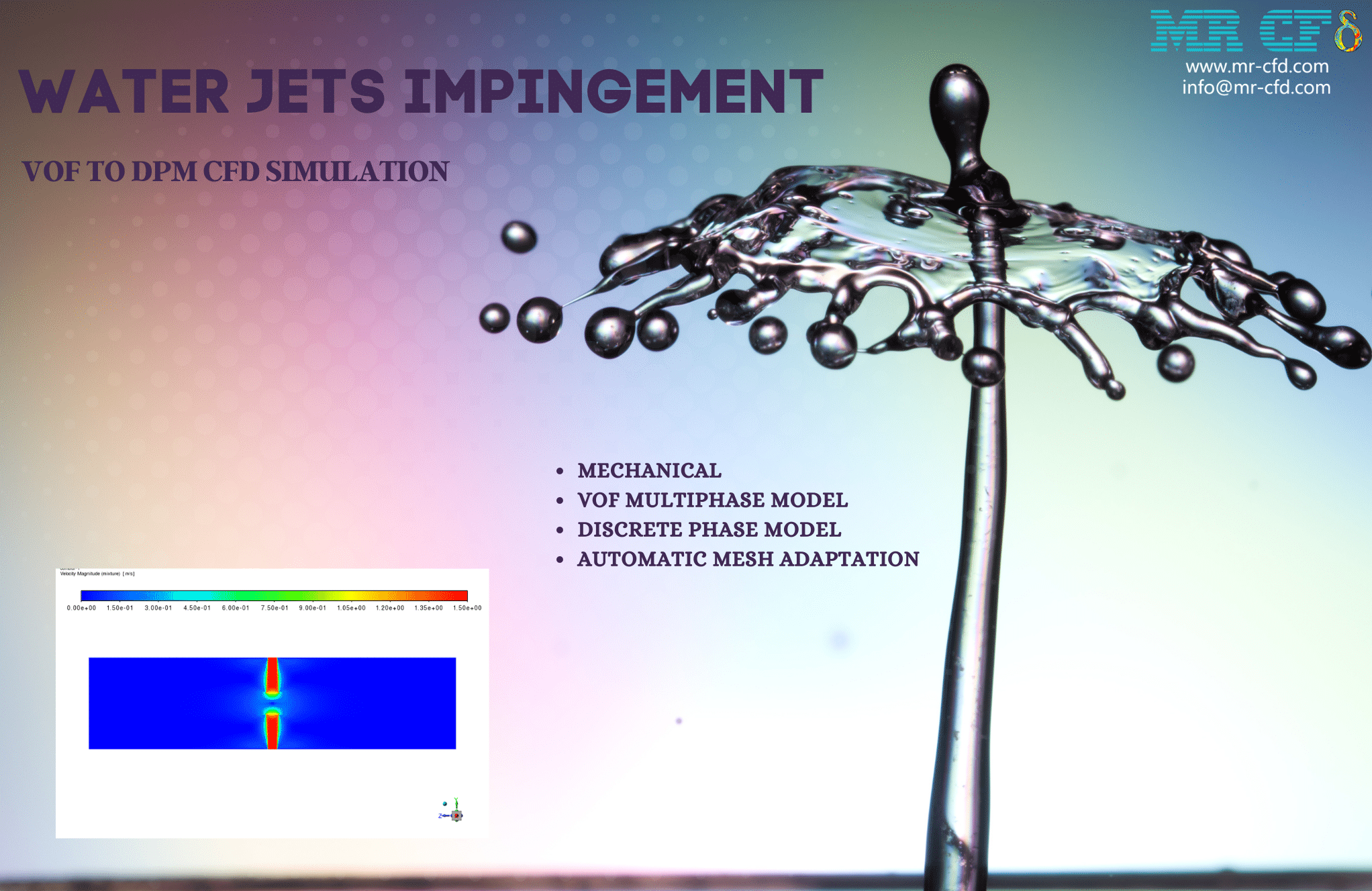

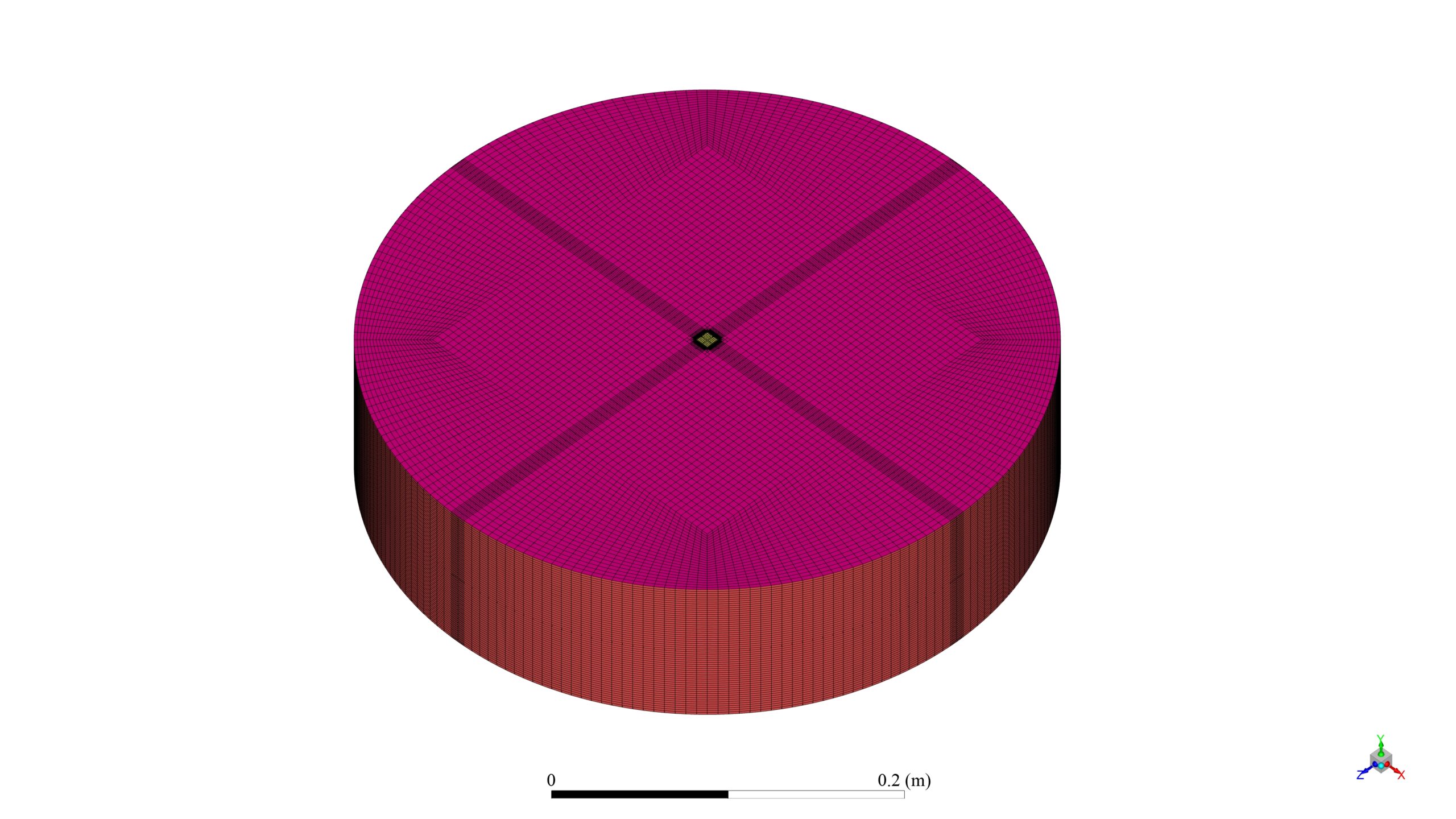
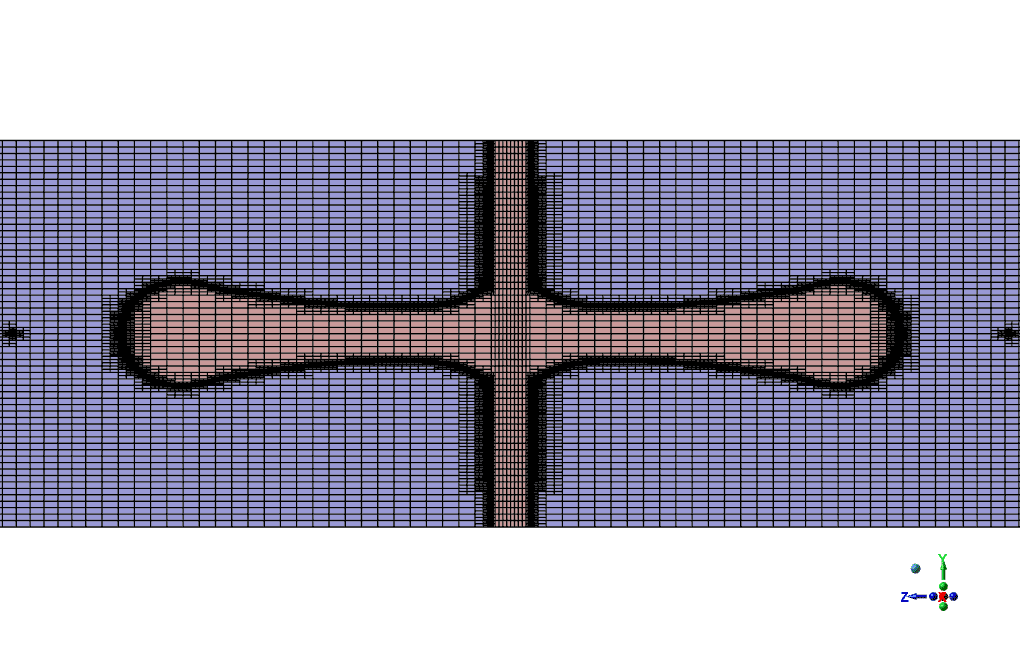

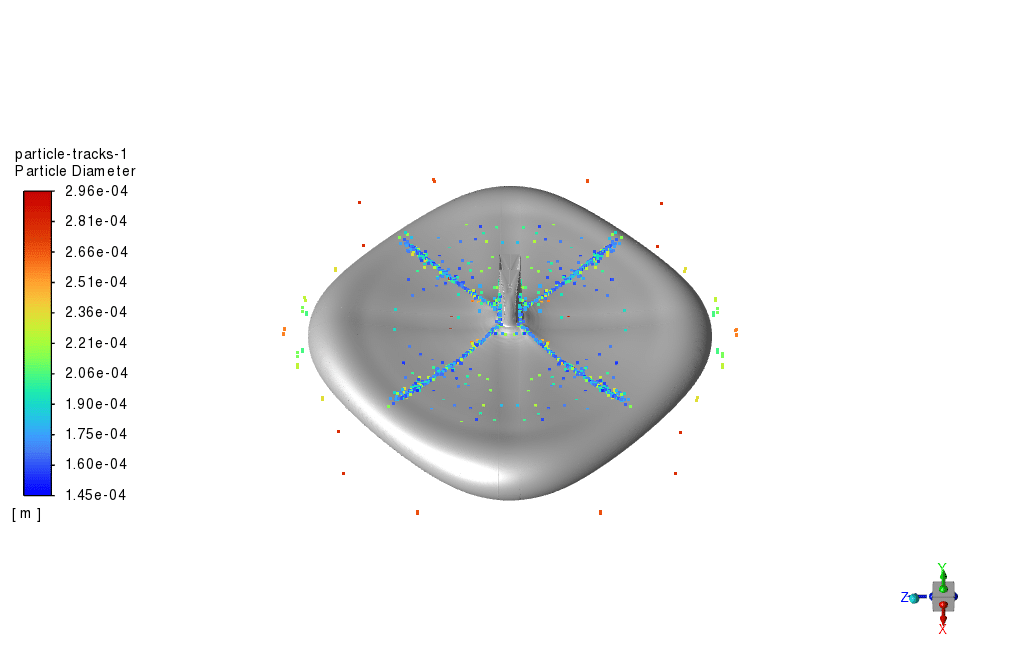
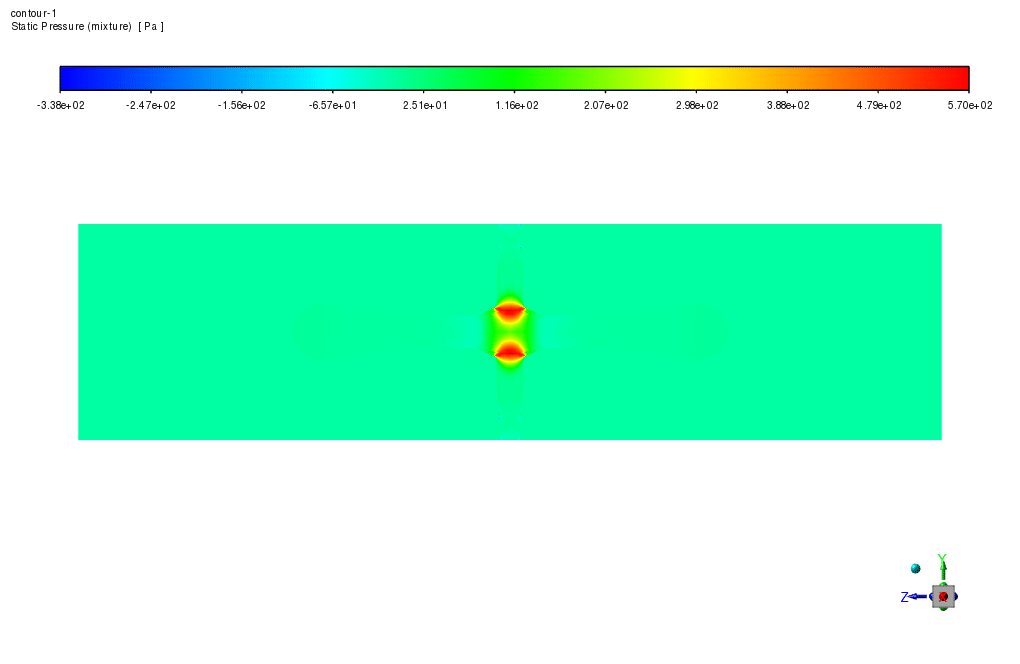
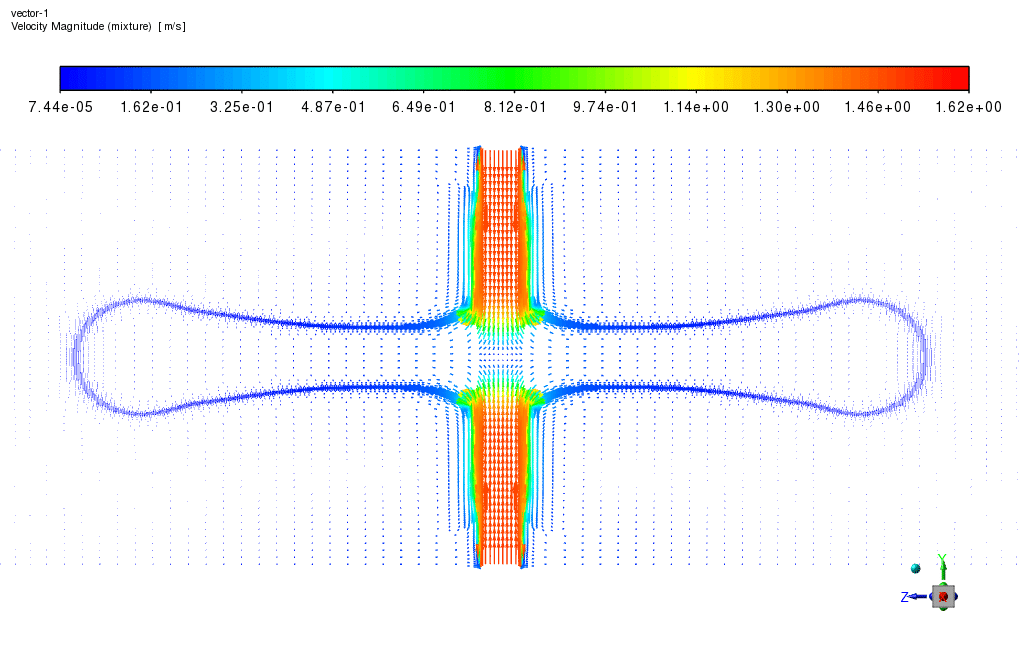

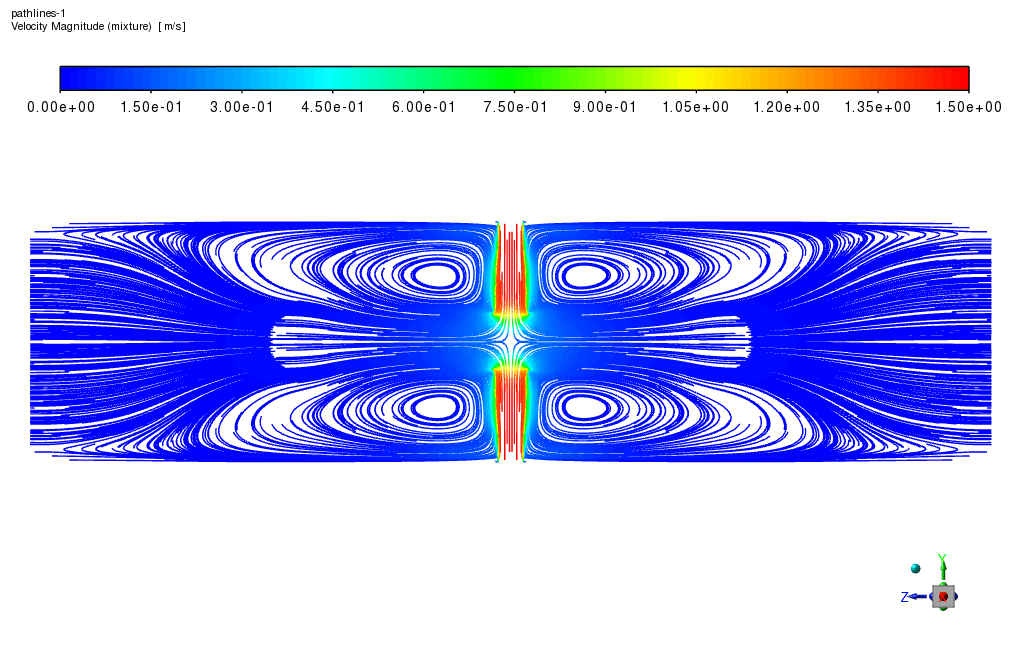




Mrs. Annamarie Torphy V –
Can you please explain how the automatic mesh adaptation works in the context of the jet impingement process within the simulation?
MR CFD Support –
In this simulation, the automatic mesh adaptation is utilized to refine or coarsen the mesh dynamically as the simulation progresses. Initially, when the jets are not present, a coarser mesh is sufficient. As the water jets begin to impinge and form a fluid-air interface, the mesh automatically refines in that region to capture the flow intricacies and droplet formation accurately. After droplets form and the focus is no longer on the interface, the mesh can revert to its original size, conserving computational resources while still resolving necessary details. This adaptive process ensures a balance between numerical accuracy and computational efficiency.
Dr. Stella Miller –
I recently finished the ‘VOF to DPM, Water Jets Impingement CFD Simulation’ course from MR CFD and found the balance between theory and practical application impressive. The guidance on mesh adaptations and using the different modules was clear, and seeing the CFD results validated the area-of-study. This will help a ton in my ongoing research work.
MR CFD Support –
Thank you for your thoughtful feedback! We’re delighted to hear that our training course helped bridge the gap between theoretical concepts and practical implementation for your research. Your success is what we aim for, and it’s great knowing that the course was beneficial. Keep us posted on your research progress, we appreciate your input!
Ada Bauch –
This course sounds technical. How manageable is it for someone new to CFD and ANSYS Fluent?
MR CFD Support –
The course on VOF to DPM Water Jets Impingement CFD Simulation is designed to be comprehensive and guided, which makes it manageable for someone who might be new to CFD and ANSYS Fluent. However, a basic understanding of fluid dynamics and simulation concepts would be beneficial. The course includes step-by-step instructions and a variety of learning aids to help you through the learning process.
Miss Brooklyn Kihn –
What are the criteria for automatic mesh adaptation in the simulation of the jet impingement project?
MR CFD Support –
The criteria for automatic mesh adaptation in the jet impingement project are based on capturing the accurate dynamics of the fluid interface and the droplets’ formation. It focuses on refining the mesh cells at the water and air interface to ensure that flow instabilities and surface tension effects are properly resolved to predict the droplet formation, diameter, and velocities with higher precision.
Marlen Franecki –
I’m curious about how the automatic mesh adaptation feature works. Could you explain what prompts it to refine the mesh and how it decides the areas that need more refinement?
MR CFD Support –
In this simulation, the automatic mesh adaptation is triggered by the fluid-air interface generated by the impingement of water jets. The mesh is refined in regions where the interface between water and air is present to capture the flow details accurately and model the droplet formation process. This results in smaller mesh cells at the interface, ensuring that the surface tension effects which are crucial for predicting droplet formation, size, and velocity, are resolved correctly.
Vella Romaguera –
Beautifully detailed training on water jets impingement using VOF to DPM in ANSYS Fluent. The integration of multiple simulation approaches to accurately model such a complex process is impressive. I particularly appreciated the blend of theoretical explanation and practical application, making it easier to grasp the complicated dynamics involved in jet impingement processes.
MR CFD Support –
Thank you for your positive feedback! We’re delighted to hear that the training materials provided clarity and value in understanding the water jets impingement phenomena. Our goal is always to offer comprehensive resources that bridge theory with practice effectively. Your appreciation truly motivates us.
Elmore Gutmann –
I was totally wowed by how the VOF to DPM transition was handled in the simulation. Seeing the jet impingement process and the formation of droplets was incredibly satisfying. Keep up with the truly insightful products!
MR CFD Support –
Thank you for your kind words! We’re glad that our VOF to DPM, Water Jets Impingement CFD Simulation training product has impressed you and provided you with the insights you were looking for. Your satisfaction motivates us to continue providing high-quality simulations and training materials!
Arielle Morar DVM –
The description was spot on and truly highlights how effective the VOF to DPM simulation is for jet impingement analyses! It’s evident how this can critically benefit sectors ranging from cooling systems to food processing. Great job on utilizing ANSYS Fluent’s capabilities!
MR CFD Support –
Thank you for your feedback! We’re thrilled to hear that the project description met your expectations and helped convey the usefulness of VOF to DPM simulations in ANSYS Fluent for real-world applications. Your acknowledgment is greatly appreciated!
Joy Witting –
Outstanding learning experience! The VOF to DPM course offered clear explanations about jet impingement, and I’ve seen a significant improvement in my understanding since employing this simulation technique. The course made the complex interactions incredibly accessible. Thanks, MR CFD!
MR CFD Support –
We are thrilled to hear that you had an outstanding learning experience with our VOF to DPM tutorial and that it has enhanced your understanding of jet impingement processes. Thank you for choosing MR CFD, and we appreciate your positive feedback!
Veda Schulist –
I’m fascinated by the transition from VOF to DPM in the simulation. Can you clarify if the model automatically detects when to transition between the VOF method and DPM, or is there manual input required to trigger this change?
MR CFD Support –
In the simulation, the model is designed to automatically detect when to transition between the VOF method and DPM based on the defined criteria within ANSYS Fluent. No manual input is necessary as the model relies on built-in transition mechanisms, namely DPM-to-VOF and VOF-to-DPM, which activate under specific flow conditions encountered in the jet impingement process. The automation of the mesh adaptation to refine cells over the fluid-air interface further enables accurate capturing and tracking of these transitions.
Colby Stoltenberg –
The water jet impingement simulation sounds complex. Could you detail how the transition from the VOF model to the DPM model is handled in the simulation?
MR CFD Support –
The transition from the VOF model to the DPM model in the simulation is managed by enabling both the VOF multiphase and DPM modules, which allows use of the DPM-to-VOF and VOF-to-DPM transition mechanisms. As jets impinge and form a liquid surface, the mesh adapts, refining over the water and air interface. Once liquid turns into droplets, they’re tracked using the DPM model, where mesh cells can return to original size as intricate tracking is no longer necessary for smaller droplets.
Percival Raynor –
Can this simulation also track the heat transfer during the jets impingement process?
MR CFD Support –
Yes, the simulation has the capability to track heat transfer rates, as the characteristics of jet impingement processes can be studied in detail using VOF to DPM simulations in ANSYS Fluent. This helps in optimizing cooling techniques, understanding heat exchanger functionality, and assessing process efficiencies in many industrial applications.
Dr. Cristopher Lind IV –
The provided project was fascinating, especially how it combines the VOF and DPM models to simulate droplet formation through jet impingement. The attention to detail Enables an in-depth analysis of the heat transfer mechanisms relevant to several industries. The mesh adaption technique seemed particularly important for this process. After implementing these approaches in practice, the learning gains are quite substantial, making the experience with ANSYS Fluent not just instructive, but also quite immersive.
MR CFD Support –
Thank you for taking the time to provide such a thoughtful review of our VOF to DPM, Water Jets Impingement CFD Simulation training using ANSYS Fluent. We’re thrilled to hear that you found the combination of the VOF and DPM models informative and that you appreciate the intricacies of the simulation techniques implemented, including the mesh adaption. It’s our goal to provide a hands-on and detailed learning experience, and we’re glad to have achieved that with your experience. We’re honored to have contributed to your understanding of these important processes. If you have any further questions or need additional learning materials, please don’t hesitate to reach out!
Dr. Pietro Keebler –
Wonderful learning experience! The detailed information on the jet impingement process and the application of VOF to DPM in ANSYS Fluent helped me understand a complex phenomenon with ease. The simulation not only showcased the impact and the droplet formation clearly, but also the adaptation of the mesh for accurate results was impressive. I’m looking forward to applying these techniques to my own projects, particularly interested in how cooling methods might be optimized as detailed in the conclusions.
MR CFD Support –
Thank you for your feedback! We’re thrilled to hear that our training material provided a clear understanding of the complex jet impingement process and that the VOF to DPM simulation was helpful for your learning. It’s great to know that you’re inspired to apply these techniques to your own projects. If you have any more questions or need further assistance, feel free to reach out to us. Good luck with optimizing your cooling methods, we’re confident that with the knowledge gained, you’ll make significant strides in your work.
Jerome Stokes –
The training was incredible! The VOF to DPM transition was beautifully illustrated and provided clear insights into the particle tracking complexities.
MR CFD Support –
We’re thrilled to hear that you found the VOF to DPM simulation training useful and insightful. Our team works hard to create a clear and detailed understanding of particle tracking and multiphase flow behavior, and it’s great to see our efforts reflected in your learning experience. Thank you for your positive feedback!
Dr. Greyson Stroman –
The description mentions automatic mesh adaptation for the VOF to DPM simulation. Can you explain how this feature concretely impacts the accuracy of simulation results?
MR CFD Support –
The automatic mesh adaptation feature dynamically refines or coarsens the mesh in regions where fluid phase changes occur or particles are formed. This leads to more accurate capturing of interface dynamics and particle behavior, directly impacting the fidelity of the simulation with improved prediction of the fluid behavior, interface instabilities, droplet formation, size, trajectory, and ultimately the efficiency of the jet impingement process.
Dustin O’Reilly –
This VOF to DPM CFD Simulation training sounds fantastic for understanding jet impingement. I’m curious, does the mesh refinement during the simulation affect computation time significantly?
MR CFD Support –
The adaptive mesh refinement technique optimizes computation by concentrating resources where they are most needed. While such refining can increase computation time due to the increased number of cells requiring calculation, its intelligent application ensures that it does not impact the overall time significantly. The gains in accuracy generally justify the potential increase in computation time.
Roderick Rosenbaum –
Impressive details and extensive study on the VOF to DPM water jets impingement! The results insight on jet impact, droplet formation, and behavior under different velocities are pragmatic for industry-critical applications. Stellar job by MR CFD in simplifying complex phenomena through precise simulations.
MR CFD Support –
We truly appreciate your positive feedback on the VOF to DPM, Water Jets Impingement CFD Simulation training. It gratifies us to know that the detail level and insights provided by our simulation can deliver such value for your understanding and implementation in practical scenarios. Thank you for taking the time to acknowledge the effectiveness of our product. If you need further assistance or more information on CFD training and simulations, please don’t hesitate to reach out.